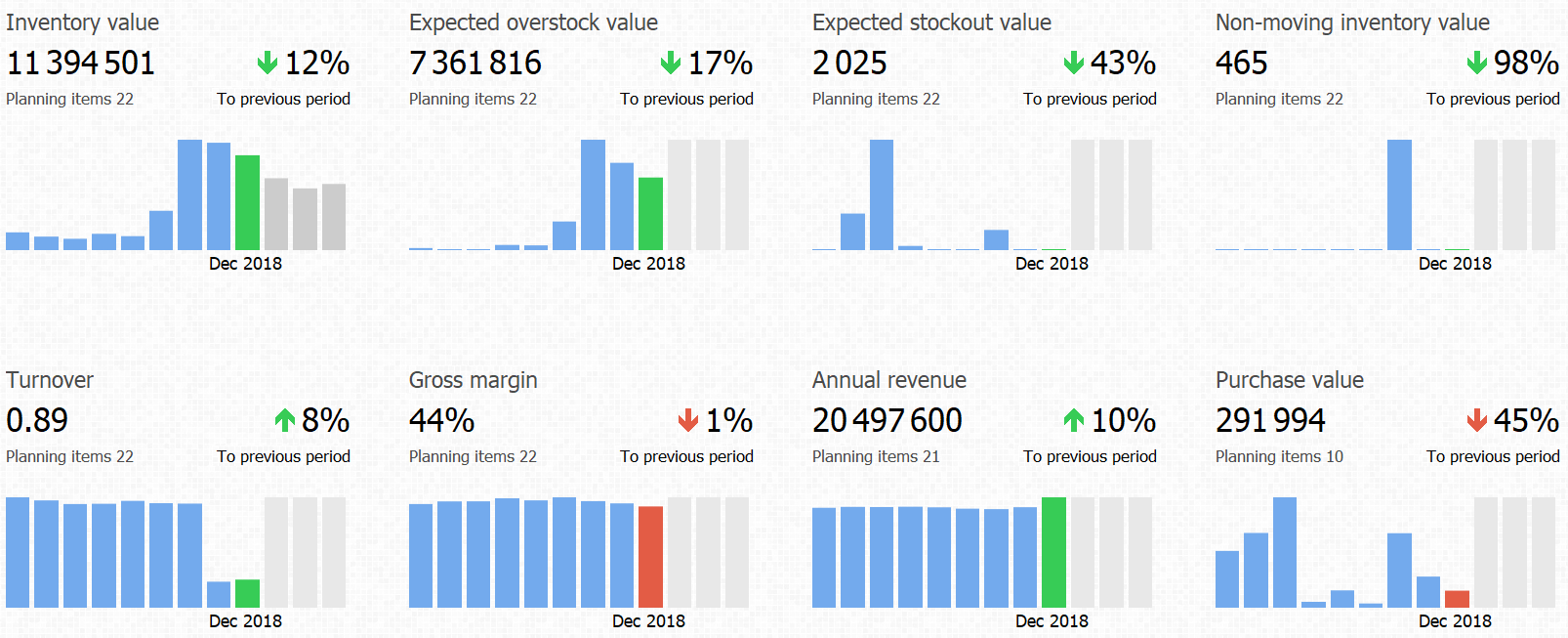4 Crucial Elements of Demand Planning in 2025
How to Unleash the Full Potential of Your Business

Table of Contents:
- Introduction
- 1. Appropriate product history
- 2. Internal trends
- 3. External trends
- 4. Events and promotions
- Summary
- Bonus: 10 best demand planning software (+1 Free Tool)
Introduction
Businesses such as retailers, wholesalers, distributors, manufacturers and ecommerce are extremely dependent on demand, but are only profitable and sustainable businesses if constantly improving demand planning strategies and accuracy. They spend a lot of time studying and evaluating data, analyzing sales, and improving demand forecast and demand planning accuracy.
First, let’s define what demand forecast and demand planning are and what is the difference between them. When we refer to a demand forecast we are talking about a prediction of the quantity of the product that is going to be sold, transferred or otherwise used during a specific time period. Demand planning is a process of planning future operations based on a previously made forecast. The advantages of an accurate forecast and planning, of course, include better purchasing if you have a good idea of what your customer is going to request from you, you can buy and sell better.
A good analogy would be a weather forecast. If we know what the weather will be on a specific day and it is accurate, we know how to dress. If we do not know the weather forecast, we probably have to carry extra clothes as well as an umbrella just in case. By carrying all of these, you are losing a lot of resources: your energy, time, and probably opportunities (what if you need something you could have taken instead of those clothes?). But the situation is even more serious when we talk of demand forecasting and better corporate planning because we may sometimes be dealing with millions of dollars or more.
The most common method of forecasting is just looking at past usage history and assuming the next periods will behave the same. Being the most common method it is also the most common mistake. Since last year many changes may have arisen (different market tendencies, your market share, competitors’ new products, and others) and all of these changes influence demand, sales, and your profit as a result. It is not enough to rely on a just simple average of past usage in developing your forecast. The results can be spectacular when businesses focus on improving the accuracy of their forecast.
In these challenging economic times, we are seeing more and more companies paying attention to the forecast and internal operations try and make them more and more efficient and to do more with limited corporate resources. To make demand forecast as accurate as possible we usually recommend to base it on four crucial elements.
1. Appropriate product history
Past-periods’ data is usually used as the basis for forecasting future data or trends. So, basically what was sold in the past may be a good indication of what we can sell in the future. But not all data is equally useful for creating demand forecast. It is essential to choose the right period and to find the relevant history depth. If you take historical data from that is too old and from periods which do not correlate with contemporary demands, you will have an inaccurate forecast. The same bad situation occurs if you are using not enough data to create a demand forecast, so the right amount of historical data is crucial.
We recommend at least 24 months of sales data so that GMDH Streamline can automatically see seasonality. When less than 24 months of information are used, depending on the data, the demand model may be just a trend (although a very smart trend!).
An adequate data weighting should also be applied. Usually, the exponential law is applied – which is assigning a higher weight to the latest data. However, there are cases when the last year’s data is irregular and different approaches are to be used. In these situations, it is better to avoid weighing or use the same weights for the selected part of the history.
In order to get the most reliable forecast, it is advisable to use demand-based data rather than a sales-based one. The difference is that sales data shows how much sales there were during some period, while demand data shows us how much sales could have been or our true potential on the market. A good example of this is lost sales, when there was no product in stock. These are easily handled in Streamline, preventing you from demand forecast inaccuracy and lost sales in the future. The software pulls daily on-hand information from the ERP system and uses the information about stockouts to determine the true demand and to adjust the forecast automatically.
Moreover Streamline gives an opportunity to correct historical data for amending the actual sales. It is a unique feature which we have developed in Streamline.
2. Internal trends
These are trends in consumption determined on the basis of historical data. Internal trends reflect one or another pattern of sales of the product or group of products. Your sales pattern may go upwards during some periods and you see the increase, or it may go downwards, making you think of optimization of business, or there may be some seasonal patterns. For example, a ‘winter product’ barely sells between April and August, and sells strongly through the fall and early winter months with a huge peak in December. Once these seasonal sales patterns become evident this knowledge can be put to good use in planning production and shipping.
Talking about demand forecasting, it is necessary to select the right methods and models for forecasting according to the sales pattern. As well it is of high importance to understand what part of the pattern is relevant, because choosing the wrong method may affect the accuracy of the forecast and as the result to plan too much or too little inventory. Depending on this,you may have overstocks, frozen capital and slow turnover, or stock outs, dissatisfied customer and loss of sales.
Let’s also mention one more important thing. There are 2 approaches to forecasting: model competition and time series decomposition. The second is considered more reliable and accurate since the model consists of components that correspond to a particular characteristic of the data pattern. In Streamline, this approach is applied.
3. External trends
External trends usually influence businesses even more intensively then internal ones. Various external factors can impact the ability of a business or investment to achieve its strategic goals and objectives. These external factors might include competition, socio-cultural, legal, technological changes, economy, and political environment.
Considering the economy, we should mention unexpected crises and occasional economic boosts. Sales depend on the wealth of a population, so when economic conditions aren’t bright, you need to adjust your strategy. This could mean layoffs and other cost-cutting measures, price reductions to increase sales volume etc.
Cultural Shifts. The society we live in dictates our personal values to a large degree, including the types of products we buy, the places we go, and the services we use. Shifts in culture, therefore, drive the demand for new gadgets, clothing, food, clothing, music, and even business systems.
Political forces and government intervention can create a market or practically destroy it, as in the case of alcohol during the Prohibition. It could have a direct impact on your business increasing or decreasing overall demand.
Technology, especially when widely adopted rapidly, is always a major disruptor and game-changer, and there are many examples of industry leaders who ignored technological change and suffered greatly for it.
So sometimes adjustments must be done manually, ignoring some past facts and relying on common sense. With most software solutions it is rather hard to do, but in Streamline we can do it for you quick and easy.
Considering both internal and external trends, as well as appropriate product history any business wants to grab customers attention. Therefore we usually hold different events and promotions, which is the next thing to keep in mind working on demand planning.
4. Events and promotions
Different events and promotions usually have a substantial effect on the future demand of products. If you are promoting products, hopefully, you are going to see an increase in sales. That increase in sales must be a part of your prediction or you will not buy enough to meet this increased demand. Streamline gives you an opportunity to add all of the necessary information manually to adjust the forecast perfectly for your business.
It is also important to build an adequate forecast in such frequent cases as launching new products or replacing old products with “new” ones. I am sure you are familiar with such marketing method as substitution (creating an analogue to a previous product), which always helps restart customers’ interest.
It is obvious that holidays and calendar events also strongly affect sales and marketing. Black Friday or Christmas sometimes may have better sales in one day than you may usually sell in 30 regular days. If that’s the case, common sense tells us to pay close attention and plan calendar events as accurately as possible. In addition, since different countries have different holidays and calendars, in Streamline you can create your own customized calendar, and the system will capture sales jumps according to it.
Summary
Since the slight change by either increase or decrease in demand has a corresponding effect on revenues and profits, it is crucial for any business to improve forecast and increase planing accuracy. In order to give businesses an effective tool for inventory and demand forecast, because we understand how it influences profits, we have developed Streamline.
We recommend using data for at least 24 months since it is important to choose the right amount and depth of history. It is important to build an adequate forecast based on the right model, but it is also crucial to have the possibility to make manual changes in the system, considering not only internal but also external trends, promotions, and events.
Many businesses do not understand the advantage of getting a good forecast and do not spend much time developing their predictions of future demand. However, the best results come to those companies which see demand forecast and planning as a part of their operational strategy, and to make the process one-click easy, we developed Streamline.
Bonus: Top demand planning software
The best demand planning software to automate all of the above.
Further Reading:
- Planning Demand and Supply in a Supply Chain [PDF] by The University of Texas at Dallas
- Cross-Functional Alignment in Supply Chain Planning: A Case Study of Sales and Operations Planning [PDF]
- Demand & Supply Management: Collaborative Planning, Forecasting & Replenishment
- Demand planning and inventory control by University of Minnesota
Still relying on manual work in Excel for planning?
Automate demand and supply planning with Streamline today!
- Achieve optimal 95-99%+ inventory availability, ensuring you can meet customer demand consistently.
- Attain up to 99% forecast accuracy, getting more reliable planning and decision-making.
- Experience up to a 98% reduction in stockouts, minimizing missed sales opportunities and customer dissatisfaction.
- Cut excess inventory by up to 50%, freeing up valuable capital and storage space.
- Increase margins by 1-5 percentage points, boosting overall profitability.
- Enjoy up to 56 times ROI within one year, with a 100% ROI achievable in the first three months.
- Reduce the time spent on forecasting, planning, and ordering by up to 90%, allowing your team to focus on strategic activities.
